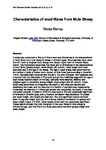Characteristics of wool fibres from Mule Sheep
| dc.contributor.author | Bishop, N. | |
| dc.date.accessioned | 2019-05-13T15:04:52Z | |
| dc.date.available | 2019-05-13T15:04:52Z | |
| dc.date.issued | 2010 | |
| dc.identifier.citation |
Bishop, N. (2010) 'Characteristics of wool fibres from Mule Sheep', The Plymouth Student Scientist, p. 2-15. | en_US |
| dc.identifier.issn | 1754-2383 | |
| dc.identifier.uri | http://hdl.handle.net/10026.1/13908 | |
| dc.description.abstract |
A study was conducted to find out if there were any differences in the characteristics of wool fibres from mule sheep in sheep of different ages. Wool samples were taken from 91 North of England Mule Sheep from Seale Hayne Farm in Newton Abbot, Devon. The hypothesis tested was that there are no differences in the characteristics of wool fibres (greasy weight, clean weight, dirt content, mean length and mean diameter) due to the age of the sheep. The age of each sheep was determined by the number of pairs of incisor teeth located on their lower jaw according to Goodwin (1979). Samples were collected with the aid of the farm manager, farm assistant and a lecturer from the University of Plymouth and put into individual bags with the age of each sheep labelled clearly on the bag. Samples were weighed, washed and weighed again to determine greasy weight, clean weight and dirt content. Mean length was determined by measuring the length of two fibres per sample and calculating the mean, and the diameter of a handful of samples was measured by measuring the diameter of 5 fibres per sample and calculating the mean. A one-way unstacked analysis of variance (ANOVA) was used to find any statistically significant differences in different ages, and a Pearson correlation was calculated for greasy and clean weight, and length and diameter. The only significant results returned were for age and length (p=0.05) and a strong Pearson Correlation for greasy and clean weight (value of 0.990). Other results found were not statistically significant. These results showed that only the length of the wool fibres in mule sheep is affected by age, and that there is a linear association between greasy weight and clean weight. | en_US |
| dc.language.iso | en | en_US |
| dc.publisher | University of Plymouth | |
| dc.rights | Attribution 3.0 United States | * |
| dc.rights.uri | http://creativecommons.org/licenses/by/3.0/us/ | * |
| dc.subject | Sheep | en_US |
| dc.subject | wool fibres | en_US |
| dc.subject | Seale Hayne Farm | en_US |
| dc.subject | Newton Abbot | en_US |
| dc.subject | North of England Mule Sheep | en_US |
| dc.subject | Mule Sheep | en_US |
| dc.subject | Wool | en_US |
| dc.subject | characteristics of wool | en_US |
| dc.title | Characteristics of wool fibres from Mule Sheep | en_US |
| dc.type | Article | |
| plymouth.issue | 1 | |
| plymouth.volume | 3 | |
| plymouth.journal | The Plymouth Student Scientist |



